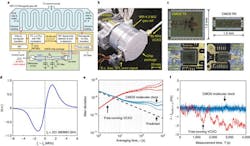Atomic clocks based on stimulated resonance of cesium 133 or rubidium atoms are the most accurate clocks in relatively widespread use (there’s one in each GPS satellite), but they’re costly and relatively large. Even the chip-scale atomic clocks for specialty applications such as military-mission synchronization in the field cost on the order of $1,000.
However, a team at MIT’s Department of Electrical Engineering and Computer Science (EECS) working with their Terahertz Integrated Electronics Group (TIEG) has developed a clock that’s almost as good. It’s built as an IC, with corresponding reduction in size, power, and cost.
Their “molecular” clock relies on measuring the rotation of molecular carbonyl sulfide (OCS), when exposed to certain frequencies; that’s why it is called “molecular” and not “atomic.” (Note: carbonyl sulfide—more formally, 16O12C32S—is a chemical compound with other often-used designations and abbreviations as well.)
Measurements show that the molecular clock had an average error of less than one microsecond per hour, which is comparable to miniature atomic clocks and four orders of magnitude more stable than mid-range crystal-oscillator clocks such as those used in smartphones. Even better, this clock is fully electronic, doesn’t require bulky or power-hungry support components to insulate and excite the molecules, and is fabricated using standard CMOS IC processes (see figure).
Some perspectives on the design, implementation, and measurement results of the MIT-developed chip-scale, silicon molecular clock. (Source: MIT)
Their report, “An on-chip fully electronic molecular clock based on sub-terahertz rotational spectroscopy” published in Nature Electronics, describes the principles, design, and operation, as well as tests. It also explains what advances this topology required in addition to the concept.
OCS and Terahertz Frequencies
To create the needed molecular resonance, which is the basis for the approach, they attached a “gas cell” filled with OCS. The IC generates and sweeps a variable-frequency terahertz (THz) signal across the cell that incites the molecules to start rotating. At the same time, a THz receiver measures the energy of these rotations and adjusts the THz oscillation frequency via a closed-loop arrangement. The OCS molecules reach peak rotation and show a sharp signal response very close to 231.060983 GHz, which is their “natural” resonance frequency. The THz source clock at this resonance frequency is then divided down to generate standard one-pulse-per-second timing pulses.
The team had to develop a controllable, tunable THz source. It was accomplished by utilizing custom metal structures plus other components to enhance the performance of on-chip transistors used to upconvert the initial low-frequency input signal into THz output. They also wanted to consume as little power as possible; the device dissipates just 66 mW.
The paper’s authors conclude that “Our work demonstrates the feasibility of monolithic integration of atomic-clock-grade frequency references in mainstream silicon-chip systems.” In addition to the paper’s expected references on molecular clocks and OCS, the paper contains many interesting historical and tutorial references on the design, technology, and construction of full-size and chip-scale atomic clocks.
The work was supported by a National Science Foundation CAREER award, MIT Lincoln Laboratory, MIT Center of Integrated Circuits and Systems, and a Texas Instruments Fellowship.
About the Author

Bill Schweber
Contributing Editor
Bill Schweber is an electronics engineer who has written three textbooks on electronic communications systems, as well as hundreds of technical articles, opinion columns, and product features. In past roles, he worked as a technical website manager for multiple topic-specific sites for EE Times, as well as both the Executive Editor and Analog Editor at EDN.
At Analog Devices Inc., Bill was in marketing communications (public relations). As a result, he has been on both sides of the technical PR function, presenting company products, stories, and messages to the media and also as the recipient of these.
Prior to the MarCom role at Analog, Bill was associate editor of their respected technical journal and worked in their product marketing and applications engineering groups. Before those roles, he was at Instron Corp., doing hands-on analog- and power-circuit design and systems integration for materials-testing machine controls.
Bill has an MSEE (Univ. of Mass) and BSEE (Columbia Univ.), is a Registered Professional Engineer, and holds an Advanced Class amateur radio license. He has also planned, written, and presented online courses on a variety of engineering topics, including MOSFET basics, ADC selection, and driving LEDs.


